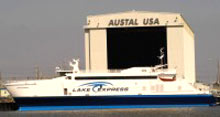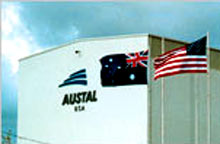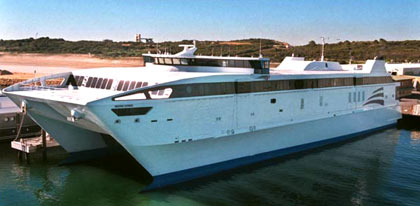to Build New Navy Ship
by JACK LYNE, Site Selection Executive Editor of Interactive Publishing
 |
|
| Austal USA's Mobile plant will build some of the initial prototypes for the Navy's new littoral combat ship (LCS). The vessel that will be made at the Alabama operation is pictured above in a rendering. | |
The
U.S. Navy's (www.navy.mil)
push to add a major new ship to its fleet is floating Austal
USA's expansion boat in a very big way. The majority-owned U.S.
subsidiary of Australia's Austal Ltd. (www.austal.com)
is adding 600 workers at its shipbuilding operation in Mobile,
Ala. (www.mobilechamber.com/economic)
The driver behind that expansion is a contract
for the Navy's new littoral combat ship (LCS). Austal's
 |
|
|
"We're going to be doing some of the highest
technology work right here," said Gov. Bob Riley (pictured with
U.S. Housing and Urban Development Secretary Alphonso Jackson
last year in the aftermath of Hurricane Ivan).
|
|
plant on the banks of the Mobile River will build LCS prototypes. The
project will more than triple the size of the Mobile plant's current
180-employee work force.
The LCD represents "the Navy's ship of the future,"
Austal USA CEO Greg Metcalf said at the expansion's Jan. 17th groundbreaking
at the company's Blakeley Island shipbuilding plant.
"This new job will deliver 600 new jobs to the
community with various trades, like aluminum fabricators and welders,
electricians and engineers," Metcalf explained. "Our first build on
that program is [set to begin in] October of this year."
Metcalf estimated that the expansion will cost
about US$20 million. He added, though, that the capital outlay could
be as high as $25 million.
The expansion will add about 120,000 sq. ft.
(10,800 sq. m.) of new shipbuilding space, said Metcalf.
 |
|
| The LCS that Austal is building (pictured in a rendering) is one of two prototypes that the Navy is considering in its effort to add a fast, highly maneuverable vessel to its fleet. | |
The project will also create more square footage for making bulkheads
(the wall-like vertical structures that separate and enclose ship compartments),
as well as adding more parking space. When the project is complete,
Austal's Mobile operation will have almost quadrupled its shipbuilding
capacity.
"I want Alabama to be on the cutting edge when
it comes to designing and building the very best," Gov. Bob Riley (R)
noted at the announcement. "We're going to be doing some of the highest
technology work right here.
"This is a partnership," Riley said of the Mobile
project.
The Mobile County Commission has already approved $2.5 million from its capital expenditure budget for expansion subsidies. County voters approved that assistance in last year's General Election voting in November.
Mobile Mayor Mike Dow is proposing another $2.5 million in assistance from the city's economic development budget. The City Council must OK that support. At press time, Austal was also in negotiations with the Alabama Development Office (www.ado.state.al.us) for another $5 million in incentives.
Teamwork is also central in the company's involvement in the Navy project. Austal USA is a partner in the General Dynamics-led alliance that secured the LCS contract work. Austal's U.S. subsidiary is designing and building the ships.
  |
||
|
Austal USA's operations in Mobile (left) last
year launched the new Lake Express ferry from the company's shipbuilding
yard the Mobile River (right). Austal Ltd. is world's largest
builder of high-speed ferries.
|
||
The General Dynamics team last year won the Navy's $78.8-million final design contract for the LCS. Austal is expanding based on that contract's $536 million in options to build the first LCS prototypes. (The U.S. Congress, however, must still formally approve the funding for building the ships.)
The Mobile expansion, said Metcalf, will be completed around the end of September. That, he explained, will coincide with the time when Austal expects to complete the LCS design that's now being done at the company's headquarters in Henderson, Western Australia. Austal centers all of its design work at its Australian operations center.
Partnering also provided Austal Ltd. with its entr‚e to set up U.S. operations. The Australian parent in late 1999 formed a joint venture with Mobile-based Bender Shipbuilding & Repair Co. (www.bendership.com) to create Austal USA. Austal Ltd. owns 70 percent of the U.S. firm, with Bender Shipbuilding controlling the other 30 percent.
 |
|
|
Austal USA built the WestPac Express (pictured)
for the U.S. Marine Corps.
|
|
Project Could Cost $14 Billion
The raison d'etre for that alliance has a very high military profile. The Navy has identified the LCS project as its No. 1 priority. Military officials say that the Navy badly needs to add a new fast, highly maneuverable boat. The LCS would address three major threats that the Navy has identified in shoreline battle environments: diesel submarines, armed small craft and mines.
"The acquisition of LCS sets a new standard for rapid procurement in support of the war-fighter," said Rear Adm. Charlie Hamilton, the Navy's deputy program executive officer for ships. "LCS takes the operational Navy into a higher tactical speed regime."
Austal USA's Mobile plant is set to build two LCS prototypes. Over the long term, though, production volume could be much higher. The Navy has identified the need for 60 LCS vessels over a 15-year span.
 |
|
| "Driven by the defense market, U.S. demand for Austal's products is now set to surpass our initial expectations," said Austal Ltd. Chairman and Executive Director John Rothwell (pictured). | |
Rival Team Building LCS
That uncertainty stems from the fact that the Navy has another team of contractors also working on the project. The second team is led by Lockheed Martin and includes Bollinger Shipyards, Gibbs & Cox and Marinette Marine.
The Navy plans to test both prototypes and then decide how to proceed. It could choose only one of the prototypes for full-scale production. On the other hand, the Navy could decide to build a LCS fleet composed of a combination of the two prototypes.

The two LCS versions under development have significant differences. The vessel that the General Dynamics team is building has an aluminum and steel-reinforced triple-hull design. The Lockheed Martin team's design is for a single-hulled steel ship.
The LCS isn't Austal USA's first contract work for the U.S. military. The company in 2001 landed the contract to build the Marine Corps' WestPac Express. The ship, which is now used in the Western Pacific, has the capacity to transport a complete battalion of more than 950 Marines and up to 550 tons (495 metric tons) of vehicles.
"Five years ago, we took the initiative to establish a shipyard in the United States, and that foresight is now being rewarded," Austal Ltd. Chairman and Executive Director John Rothwell commented after the General Dynamics team landed the LCS design contract. "Driven by the defense market, U.S. demand for Austal's products is now set to surpass our initial expectations.
 PLEASE
VISIT OUR SPONSOR • CLICK ABOVE
PLEASE
VISIT OUR SPONSOR • CLICK ABOVE 
Site
Selection Online
©2005 Conway Data, Inc.
All rights reserved. Data is from many sources and is not warranted
to be accurate or current.